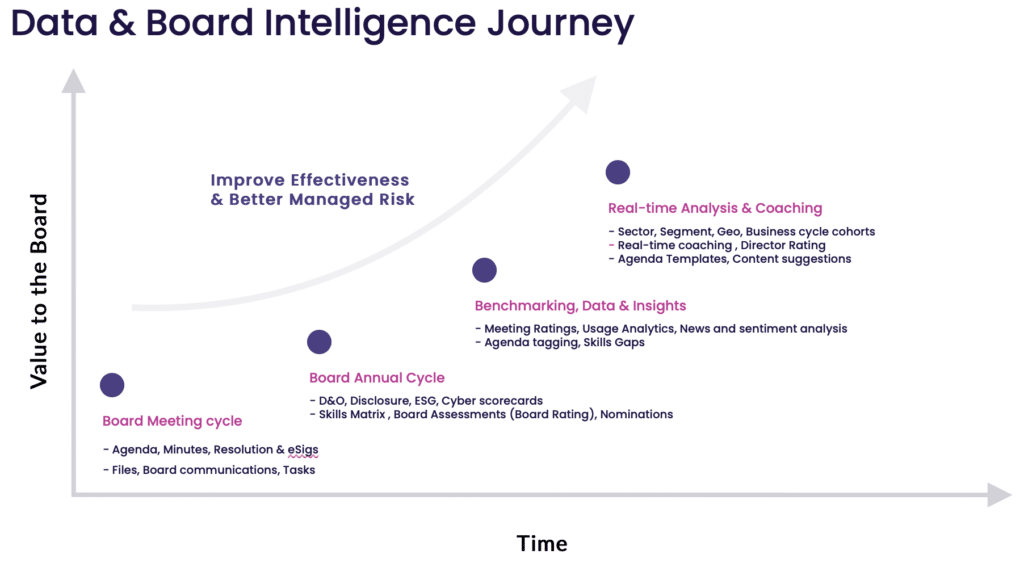
Webinar recap: OnBoard CEO Paroon Chadha and CMO Rob Kunzler show the blueprint for boards in the coming years
OnBoard Chief Marketing Officer Rob Kunzler kicked off the first Atlas Webinar with a jarring, but accurate message: “The function of boards has changed more in the last three years than any 18-year period in history.”
While that might be difficult to quantify, it’s certain that a global pandemic, cybersecurity threats, ongoing digital transformation, a volatile economy, and ongoing pushes for diversity, equity, inclusion (DEI); environmental, social and governance issues (ESG), and social justice concerns have all conspired to make boards rethink old-fashioned approaches.
“The power of digital is just starting to be harnessed,” says Paroon Chadha, OnBoard Chief Executive Officer. “I am bullish on technology. I’ve worked with plenty of board members who have needed a little help on the tech side. Work with providers, work with the board members and help them get over the hump. When it’s well-made, technology really is much simpler. When technology is poorly made, that’s when these challenges get amplified.”
Watch the Road Map for Developing Board Intelligence webinar now.

“The function of boards has changed more in the last three years than any 18-year period in history.”
Where are boards now?
The pandemic, preexisting digital transformation, and other factors listed above have led to a new normal. Boardrooms are no exception.
A few observations Chadha and Kunzler shared to illustrate that include:
- The best board meetings obsessively bias the agenda toward action.
- Exceptional virtual board engagement can be achieved by thoughtfully digitizing all board meeting aspects
- Digitally native boards are intentional about hybrid meetings, and actively prevent “digital dissing.”
- The lack of a physical third dimension can kill a board’s spirit; the best foster collaboration with technology, conversation, and engagement.
“My personal preference is to have an all-digital meeting or an all-in-person meeting,” Chadha says. Kunzler agrees, adding, “It’s tough to have eight people in a room and four people on Zoom.”
Among webinar participants, 55% said they conduct their board meetings digitally, while just 16% meet in-person. The remaining respondents (28%) said they meet in a hybrid format.
No matter where boards meet, board management software demand continues to grow. “We were broadly forced to move into a digital environment in April 2020,” Kunzler says. “Even as some boards have returned to in-person meetings, we have not seen a drop-off in the utilization of the technology.”
Where will board technology take us?
According to the National Association of Corporate Directors’ (NACD) 2022 Governance Outlook, 70.2% of poll respondents listed “increased competition for talent” was among five trends they foresee to have the greatest impact on their companies over the next 12 months.
Other categories included:
- Increased pace of digital transformation (42%)
- Slowing global supply chain (40.8%)
- Changing cybersecurity threats (38.7%)
- Growing inflation (34.9%)
Preliminary results of OnBoard’s 2022 Board Effectiveness Survey show 69% of respondents noted improved board effectiveness in the last 12 months. Sixty-two percent noted increased collaboration, and 46% cited board engagement as the primary driver of increased effectiveness.
Most importantly, long-time “tech-enabled” boards maintained efficient use of board meeting time (3 to 3.5 hours) before and after COVID. Meanwhile, first-time tech-enabled boards required more meeting time (roughly four hours).
That said, as new customers adopted and utilized technology better, new customers drove meeting times down and efficiencies up.
“People who were already invested in tech showed the way during the pandemic,” Chadha says.

How boards will get there
Data analytics and insights have taken over businesses and organizations everywhere. Boardrooms are no exception.
Deep data, with a specific domain focus, allows board members to analyze various outcomes of existing behaviors. Smart technology with well-timed and well-positioned end user coaching can add exponential value to directors, administrators, and executives.
“Our ultimate goal would be to provide you coaching tips as a board member or chairperson to improve your delivery in the boardroom,” Chadha says. “Use all of those [data] insights to nudge you in the right direction.”
The Data and Board Intelligence Journey (shown below) illustrates how various board management software tools add value to boards by using data to improve effectiveness and managing risk.
Some examples of board management software tools that can help boards complete that journey include:
- Meeting feedback: Create a continuous feedback loop to improve board meetings. But keep your standards high. “If your average meeting rating is below 4.5 [on a 1-5 scale], you need to make some improvements,” Chadha says. “An empirical number really tells you where you are.”
- Skills tracking: Build high-performing boards with insights to help recruitment and succession planning efforts.
- Board assessments: Board, committee, or CEO assessments set the foundation for development priorities and helps strengthen the organization’s governance performance and practices.
“I often don’t know at the end of the board meeting how good it could have been,” Chadha says. “You often let calls and feedback play out, then you know if it was an amazing meeting.”
Chadha often says there are three types of board meetings: The one you prepared for, the one you had, and the one you wished you had.
“Technology and intelligence can be an enabler,” Kunzler says. “It’s about leaning into intelligence and using technology to get to a better place faster.”

3 board strategies you can use right now
Boards can easily remember these by incorporating the three “C”s: cybersecurity, coaching, and construction.
- Embed cybersecurity into board digital transformation. Remember that security is equal parts technology and culture, and high security doesn’t necessarily mean complex and cumbersome.
- Coaching and change management: Invest time in benchmarking. This includes meeting ratings, skills, and agenda management. Leverage technology to complement your board’s existing benchmarks.
- Correct (technology) by construction. Choose the software that meets your needs. In 2022, all software should be easy to use and intuitive.
“Whatever technology you’re moving toward, the selection of the right technology must be intuitive and simple,” Kunzler says. “Be definitive but be empathetic with the rollout of the technology. Some are reticent to using tech, but if it’s simple and you’re definitive that this is the direction you’re going, it shouldn’t be an issue.”
Don’t miss our next Atlas Leadership Webinar, A Framework for Board Governance: Improving Board Diversity, Composition Planning, and Succession Efforts.
Meet What's Next
About The Author

- Adam Wire
- Adam Wire is a Content Marketing Manager at OnBoard who joined the company in 2021. A Ball State University graduate, Adam worked in various content marketing roles at Angi, USA Football, and Adult & Child Health following a 12-year career in newspapers. His favorite part of the job is problem-solving and helping teammates achieve their goals. He lives in Indianapolis with his wife and two dogs. He’s an avid sports fan and foodie who also enjoys lawn and yard work and running.
Latest entries
 Board Management SoftwareApril 12, 2024Board of Directors Compliance Training: 5 Best Programs
Board Management SoftwareApril 12, 2024Board of Directors Compliance Training: 5 Best Programs Board Management SoftwareApril 10, 20245 Best Compliance Training Programs
Board Management SoftwareApril 10, 20245 Best Compliance Training Programs Board Management SoftwareMarch 28, 20245 Advantages of an Initial Public Offering
Board Management SoftwareMarch 28, 20245 Advantages of an Initial Public Offering Board Management SoftwareMarch 26, 2024Initial Public Offering Examples: 3 Companies That Went Public
Board Management SoftwareMarch 26, 2024Initial Public Offering Examples: 3 Companies That Went Public
